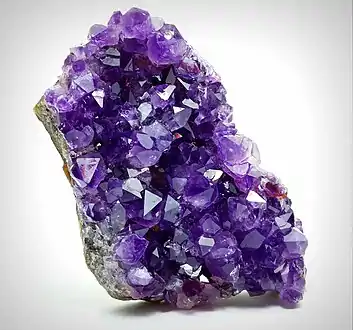Portal maintenance status: (May 2019)
|
The Minerals Portal
In geology and mineralogy, a mineral or mineral species is, broadly speaking, a solid substance with a fairly well-defined chemical composition and a specific crystal structure that occurs naturally in pure form.
The geological definition of mineral normally excludes compounds that occur only in living organisms. However, some minerals are often biogenic (such as calcite) or organic compounds in the sense of chemistry (such as mellite). Moreover, living organisms often synthesize inorganic minerals (such as hydroxylapatite) that also occur in rocks.
The concept of mineral is distinct from rock, which is any bulk solid geologic material that is relatively homogeneous at a large enough scale. A rock may consist of one type of mineral or may be an aggregate of two or more different types of minerals, spacially segregated into distinct phases.
Some natural solid substances without a definite crystalline structure, such as opal or obsidian, are more properly called mineraloids. If a chemical compound occurs naturally with different crystal structures, each structure is considered a different mineral species. Thus, for example, quartz and stishovite are two different minerals consisting of the same compound, silicon dioxide. (Full article...)
Mineralogy is a subject of geology specializing in the scientific study of the chemistry, crystal structure, and physical (including optical) properties of minerals and mineralized artifacts. Specific studies within mineralogy include the processes of mineral origin and formation, classification of minerals, their geographical distribution, as well as their utilization. (Full article...)
Selected articles
 Image 1
Image 1
Cinnabar (/ˈsɪnəˌbɑːr/; from Ancient Greek κιννάβαρι (kinnábari)), or cinnabarite (/ˌsɪnəˈbɑːraɪt/), is the bright scarlet to brick-red form of mercury(II) sulfide (HgS). It is the most common source ore for refining elemental mercury and is the historic source for the brilliant red or scarlet pigment termed vermilion and associated red mercury pigments.
Cinnabar generally occurs as a vein-filling mineral associated with recent volcanic activity and alkaline hot springs. The mineral resembles quartz in symmetry and in its exhibiting birefringence. Cinnabar has a mean refractive index near 3.2, a hardness between 2.0 and 2.5, and a specific gravity of approximately 8.1. The color and properties derive from a structure that is a hexagonal crystalline lattice belonging to the trigonal crystal system, crystals that sometimes exhibit twinning.
Cinnabar has been used for its color since antiquity in the Near East, including as a rouge-type cosmetic, in the New World since the Olmec culture, and in China since as early as the Yangshao culture, where it was used in coloring stoneware.
Associated modern precautions for use and handling of cinnabar arise from the toxicity of the mercury component, which was recognized as early as ancient Rome. (Full article...) Image 2
Image 2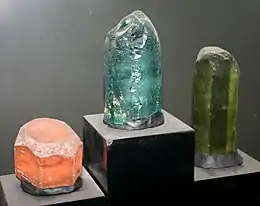
Beryl (/ˈbɛrəl/ BERR-əl) is a mineral composed of beryllium aluminium silicate with the chemical formula Be3Al2Si6O18. Well-known varieties of beryl include emerald and aquamarine. Naturally occurring, hexagonal crystals of beryl can be up to several meters in size, but terminated crystals are relatively rare. Pure beryl is colorless, but it is frequently tinted by impurities; possible colors are green, blue, yellow, pink, and red (the rarest). It is an ore source of beryllium. (Full article...) Image 3
Image 3_-_Kopalnia_soli_Wieliczka%252C_Polska.jpg.webp) Halite from the Wieliczka salt mine, Małopolskie, Poland
Halite from the Wieliczka salt mine, Małopolskie, Poland
Halite (/ˈhælaɪt, ˈheɪlaɪt/), commonly known as rock salt, is a type of salt, the mineral (natural) form of sodium chloride (NaCl). Halite forms isometric crystals. The mineral is typically colorless or white, but may also be light blue, dark blue, purple, pink, red, orange, yellow or gray depending on inclusion of other materials, impurities, and structural or isotopic abnormalities in the crystals. It commonly occurs with other evaporite deposit minerals such as several of the sulfates, halides, and borates. The name halite is derived from the Ancient Greek word for "salt", ἅλς (háls). (Full article...)![Image 4Garnets ( /ˈɡɑːrnɪt/) are a group of silicate minerals that have been used since the Bronze Age as gemstones and abrasives.All species of garnets possess similar physical properties and crystal forms, but differ in chemical composition. The different species are pyrope, almandine, spessartine, grossular (varieties of which are hessonite or cinnamon-stone and tsavorite), uvarovite and andradite. The garnets make up two solid solution series: pyrope-almandine-spessartine (pyralspite), with the composition range [Mg,Fe,Mn]3Al2(SiO4)3; and uvarovite-grossular-andradite (ugrandite), with the composition range Ca3[Cr,Al,Fe]2(SiO4)3. (Full article...)](../I/Blank.png.webp) Image 4
Image 4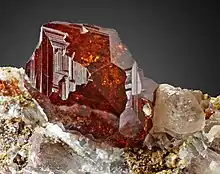
Garnets ( /ˈɡɑːrnɪt/) are a group of silicate minerals that have been used since the Bronze Age as gemstones and abrasives.
All species of garnets possess similar physical properties and crystal forms, but differ in chemical composition. The different species are pyrope, almandine, spessartine, grossular (varieties of which are hessonite or cinnamon-stone and tsavorite), uvarovite and andradite. The garnets make up two solid solution series: pyrope-almandine-spessartine (pyralspite), with the composition range [Mg,Fe,Mn]3Al2(SiO4)3; and uvarovite-grossular-andradite (ugrandite), with the composition range Ca3[Cr,Al,Fe]2(SiO4)3. (Full article...) Image 5
Image 5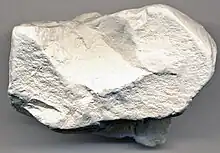
Kaolinite (/ˈkeɪ.ələˌnaɪt, -lɪ-/ KAY-ə-lə-nete, -lih-; also called kaolin) is a clay mineral, with the chemical composition Al2Si2O5(OH)4. It is a layered silicate mineral, with one tetrahedral sheet of silica (SiO4) linked through oxygen atoms to one octahedral sheet of alumina (AlO6).
Kaolinite is a soft, earthy, usually white, mineral (dioctahedral phyllosilicate clay), produced by the chemical weathering of aluminium silicate minerals like feldspar. It has a low shrink–swell capacity and a low cation-exchange capacity (1–15 meq/100 g).
Rocks that are rich in kaolinite, and halloysite, are known as kaolin (/ˈkeɪ.əlɪn/) or china clay. In many parts of the world kaolin is colored pink-orange-red by iron oxide, giving it a distinct rust hue. Lower concentrations yield white, yellow, or light orange colors. Alternating layers are sometimes found, as at Providence Canyon State Park in Georgia, United States.
Kaolin is an important raw material in many industries and applications. Commercial grades of kaolin are supplied and transported as powder, lumps, semi-dried noodle or slurry. Global production of kaolin in 2021 was estimated to be 45 million tonnes, with a total market value of $US4.24 billion. (Full article...) Image 6
Image 6 Graphite specimen
Graphite specimen
Graphite (/ˈɡræfaɪt/) is a crystalline form of the element carbon. It consists of stacked layers of graphene. Graphite occurs naturally and is the most stable form of carbon under standard conditions. Synthetic and natural graphite are consumed on large scale (300 kton/year, in 1989) for uses in pencils, lubricants, and electrodes. Under high pressures and temperatures it converts to diamond. It is a good (but not excellent) conductor of both heat and electricity. (Full article...) Image 7
Image 7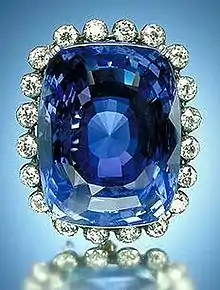 The 423-carat (85 g) blue Logan Sapphire
The 423-carat (85 g) blue Logan Sapphire
Sapphire is a precious gemstone, a variety of the mineral corundum, consisting of aluminium oxide (α-Al2O3) with trace amounts of elements such as iron, titanium, cobalt, lead, chromium, vanadium, magnesium, boron, and silicon. The name sapphire is derived via the Latin sapphirus from the Greek sappheiros (σάπφειρος), which referred to lapis lazuli. It is typically blue, but natural "fancy" sapphires also occur in yellow, purple, orange, and green colors; "parti sapphires" show two or more colors. Red corundum stones also occur, but are called rubies rather than sapphires. Pink-colored corundum may be classified either as ruby or sapphire depending on locale. Commonly, natural sapphires are cut and polished into gemstones and worn in jewelry. They also may be created synthetically in laboratories for industrial or decorative purposes in large crystal boules. Because of the remarkable hardness of sapphires – 9 on the Mohs scale (the third hardest mineral, after diamond at 10 and moissanite at 9.5) – sapphires are also used in some non-ornamental applications, such as infrared optical components, high-durability windows, wristwatch crystals and movement bearings, and very thin electronic wafers, which are used as the insulating substrates of special-purpose solid-state electronics such as integrated circuits and GaN-based blue LEDs. Sapphire is the birthstone for September and the gem of the 45th anniversary. A sapphire jubilee occurs after 65 years. (Full article...) Image 8
Image 8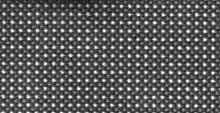 A crystalline solid: atomic resolution image of strontium titanate. Brighter spots are columns of strontium atoms and darker ones are titanium-oxygen columns.
A crystalline solid: atomic resolution image of strontium titanate. Brighter spots are columns of strontium atoms and darker ones are titanium-oxygen columns.
Crystallography is the experimental science of determining the arrangement of atoms in crystalline solids. Crystallography is a fundamental subject in the fields of materials science and solid-state physics (condensed matter physics). The word crystallography is derived from the Ancient Greek word κρύσταλλος (krústallos; "clear ice, rock-crystal"), with its meaning extending to all solids with some degree of transparency, and γράφειν (gráphein; "to write"). In July 2012, the United Nations recognised the importance of the science of crystallography by proclaiming that 2014 would be the International Year of Crystallography.
Before the development of X-ray diffraction crystallography (see below), the study of crystals was based on physical measurements of their geometry using a goniometer. This involved measuring the angles of crystal faces relative to each other and to theoretical reference axes (crystallographic axes), and establishing the symmetry of the crystal in question. The position in 3D space of each crystal face is plotted on a stereographic net such as a Wulff net or Lambert net. The pole to each face is plotted on the net. Each point is labelled with its Miller index. The final plot allows the symmetry of the crystal to be established.
Crystallographic methods now depend on analysis of the diffraction patterns of a sample targeted by a beam of some type. X-rays are most commonly used; other beams used include electrons or neutrons. Crystallographers often explicitly state the type of beam used, as in the terms X-ray crystallography, neutron diffraction and electron diffraction. These three types of radiation interact with the specimen in different ways.- X-rays interact with the spatial distribution of electrons in the sample.
- Electrons are charged particles and therefore interact with the total charge distribution of both the atomic nuclei and the electrons of the sample.
- Neutrons are scattered by the atomic nuclei through the strong nuclear forces, but in addition, the magnetic moment of neutrons is non-zero. They are therefore also scattered by magnetic fields. When neutrons are scattered from hydrogen-containing materials, they produce diffraction patterns with high noise levels. However, the material can sometimes be treated to substitute deuterium for hydrogen. Because of these different forms of interaction, the three types of radiation are suitable for different crystallographic studies.
The following sections mainly describe the use of X-rays. See these links for further information on using electrons for diffraction, crystallographic imaging, in transmission, reflection or for surfaces. For addition details on using neutrons see neutron diffraction. (Full article...) Image 9
Image 9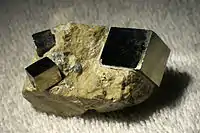 A rock containing three crystals of pyrite (FeS2). The crystal structure of pyrite is primitive cubic, and this is reflected in the cubic symmetry of its natural crystal facets.
A rock containing three crystals of pyrite (FeS2). The crystal structure of pyrite is primitive cubic, and this is reflected in the cubic symmetry of its natural crystal facets.
In crystallography, the cubic (or isometric) crystal system is a crystal system where the unit cell is in the shape of a cube. This is one of the most common and simplest shapes found in crystals and minerals.
There are three main varieties of these crystals:- Primitive cubic (abbreviated cP and alternatively called simple cubic)
- Body-centered cubic (abbreviated cI or bcc)
- Face-centered cubic (abbreviated cF or fcc)
Note: the term fcc is often used in synonym for the cubic close-packed or ccp structure occurring in metals. However, fcc stands for a face-centered-cubic Bravais lattice, which is not necessarily close-packed when a motif is set onto the lattice points. E.g. the diamond and the zincblende lattices are fcc but not close-packed.
Each is subdivided into other variants listed below. Although the unit cells in these crystals are conventionally taken to be cubes, the primitive unit cells often are not. (Full article...) Image 10
Image 10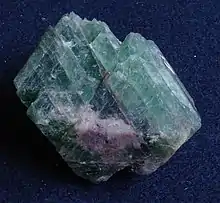 Green fluorite with prominent cleavage
Green fluorite with prominent cleavage
Cleavage, in mineralogy and materials science, is the tendency of crystalline materials to split along definite crystallographic structural planes. These planes of relative weakness are a result of the regular locations of atoms and ions in the crystal, which create smooth repeating surfaces that are visible both in the microscope and to the naked eye. If bonds in certain directions are weaker than others, the crystal will tend to split along the weakly bonded planes. These flat breaks are termed "cleavage". The classic example of cleavage is mica, which cleaves in a single direction along the basal pinacoid, making the layers seem like pages in a book. In fact, mineralogists often refer to "books of mica".
Diamond and graphite provide examples of cleavage. Each is composed solely of a single element, carbon. In diamond, each carbon atom is bonded to four others in a tetrahedral pattern with short covalent bonds. The planes of weakness (cleavage planes) in a diamond are in four directions, following the faces of the octahedron. In graphite, carbon atoms are contained in layers in a hexagonal pattern where the covalent bonds are shorter (and thus even stronger) than those of diamond. However, each layer is connected to the other with a longer and much weaker van der Waals bond. This gives graphite a single direction of cleavage, parallel to the basal pinacoid. So weak is this bond that it is broken with little force, giving graphite a slippery feel as layers shear apart. As a result, graphite makes an excellent dry lubricant.
While all single crystals will show some tendency to split along atomic planes in their crystal structure, if the differences between one direction or another are not large enough, the mineral will not display cleavage. Corundum, for example, displays no cleavage. (Full article...) Image 11
Image 11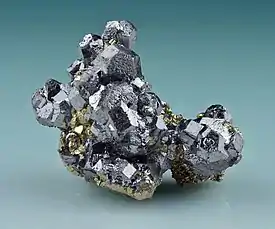 Galena with minor pyrite
Galena with minor pyrite
Galena, also called lead glance, is the natural mineral form of lead(II) sulfide (PbS). It is the most important ore of lead and an important source of silver.
Galena is one of the most abundant and widely distributed sulfide minerals. It crystallizes in the cubic crystal system often showing octahedral forms. It is often associated with the minerals sphalerite, calcite and fluorite. (Full article...) Image 12
Image 12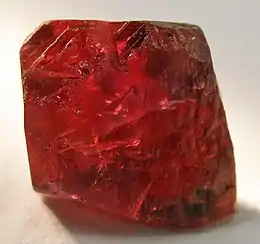 A ruby crystal from Dodoma Region, Tanzania
A ruby crystal from Dodoma Region, Tanzania
A ruby is a pinkish red to blood-red colored gemstone, a variety of the mineral corundum (aluminium oxide). Ruby is one of the most popular traditional jewelry gems and is very durable. Other varieties of gem-quality corundum are called sapphires. Ruby is one of the traditional cardinal gems, alongside amethyst, sapphire, emerald, and diamond. The word ruby comes from ruber, Latin for red. The color of a ruby is due to the element chromium.
Some gemstones that are popularly or historically called rubies, such as the Black Prince's Ruby in the British Imperial State Crown, are actually spinels. These were once known as "Balas rubies".
The quality of a ruby is determined by its color, cut, and clarity, which, along with carat weight, affect its value. The brightest and most valuable shade of red, called blood-red or pigeon blood, commands a large premium over other rubies of similar quality. After color follows clarity: similar to diamonds, a clear stone will command a premium, but a ruby without any needle-like rutile inclusions may indicate that the stone has been treated. Ruby is the traditional birthstone for July and is usually pinker than garnet, although some rhodolite garnets have a similar pinkish hue to most rubies. The world's most valuable ruby to be sold at auction is the Sunrise Ruby. (Full article...) Image 13
Image 13
Gypsum is a soft sulfate mineral composed of calcium sulfate dihydrate, with the chemical formula CaSO4·2H2O. It is widely mined and is used as a fertilizer and as the main constituent in many forms of plaster, drywall and blackboard or sidewalk chalk. Gypsum also crystallizes as translucent crystals of selenite. It forms as an evaporite mineral and as a hydration product of anhydrite. The Mohs scale of mineral hardness defines gypsum as hardness value 2 based on scratch hardness comparison.
Fine-grained white or lightly tinted forms of gypsum known as alabaster have been used for sculpture by many cultures including Ancient Egypt, Mesopotamia, Ancient Rome, the Byzantine Empire, and the Nottingham alabasters of Medieval England. (Full article...) Image 14
Image 14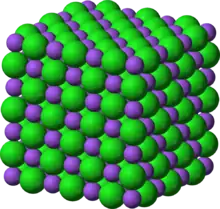 Crystal structure of table salt (sodium in purple, chlorine in green)
Crystal structure of table salt (sodium in purple, chlorine in green)
In crystallography, crystal structure is a description of the ordered arrangement of atoms, ions, or molecules in a crystalline material. Ordered structures occur from the intrinsic nature of the constituent particles to form symmetric patterns that repeat along the principal directions of three-dimensional space in matter.
The smallest group of particles in the material that constitutes this repeating pattern is the unit cell of the structure. The unit cell completely reflects the symmetry and structure of the entire crystal, which is built up by repetitive translation of the unit cell along its principal axes. The translation vectors define the nodes of the Bravais lattice.
The lengths of the principal axes, or edges, of the unit cell and the angles between them are the lattice constants, also called lattice parameters or cell parameters. The symmetry properties of the crystal are described by the concept of space groups. All possible symmetric arrangements of particles in three-dimensional space may be described by the 230 space groups.
The crystal structure and symmetry play a critical role in determining many physical properties, such as cleavage, electronic band structure, and optical transparency. (Full article...) Image 15
Image 15 Quartz crystal cluster from Brazil
Quartz crystal cluster from Brazil
Quartz is a hard, crystalline mineral composed of silica (silicon dioxide). The atoms are linked in a continuous framework of SiO4 silicon–oxygen tetrahedra, with each oxygen being shared between two tetrahedra, giving an overall chemical formula of SiO2. Quartz is the second most abundant mineral in Earth's continental crust, behind feldspar.
Quartz exists in two forms, the normal α-quartz and the high-temperature β-quartz, both of which are chiral. The transformation from α-quartz to β-quartz takes place abruptly at 573 °C (846 K; 1,063 °F). Since the transformation is accompanied by a significant change in volume, it can easily induce microfracturing of ceramics or rocks passing through this temperature threshold.
There are many different varieties of quartz, several of which are classified as gemstones. Since antiquity, varieties of quartz have been the most commonly used minerals in the making of jewelry and hardstone carvings, especially in Eurasia.
Quartz is the mineral defining the value of 7 on the Mohs scale of hardness, a qualitative scratch method for determining the hardness of a material to abrasion. (Full article...) Image 16
Image 16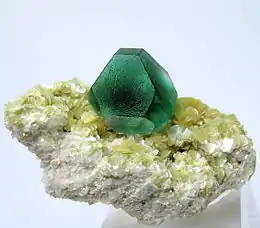 Deep green isolated fluorite crystal resembling a truncated octahedron, set upon a micaceous matrix, from Erongo Mountain, Erongo Region, Namibia (overall size: 50 mm × 27 mm, crystal size: 19 mm wide, 30 g)
Deep green isolated fluorite crystal resembling a truncated octahedron, set upon a micaceous matrix, from Erongo Mountain, Erongo Region, Namibia (overall size: 50 mm × 27 mm, crystal size: 19 mm wide, 30 g)
Fluorite (also called fluorspar) is the mineral form of calcium fluoride, CaF2. It belongs to the halide minerals. It crystallizes in isometric cubic habit, although octahedral and more complex isometric forms are not uncommon.
The Mohs scale of mineral hardness, based on scratch hardness comparison, defines value 4 as fluorite.
Pure fluorite is colourless and transparent, both in visible and ultraviolet light, but impurities usually make it a colorful mineral and the stone has ornamental and lapidary uses. Industrially, fluorite is used as a flux for smelting, and in the production of certain glasses and enamels. The purest grades of fluorite are a source of fluoride for hydrofluoric acid manufacture, which is the intermediate source of most fluorine-containing fine chemicals. Optically clear transparent fluorite lenses have low dispersion, so lenses made from it exhibit less chromatic aberration, making them valuable in microscopes and telescopes. Fluorite optics are also usable in the far-ultraviolet and mid-infrared ranges, where conventional glasses are too opaque for use. (Full article...) Image 17
Image 17
Amethyst is a violet variety of quartz. The name comes from the Koine Greek αμέθυστος amethystos from α- a-, "not" and μεθύσκω (Ancient Greek) methysko / μεθώ metho (Modern Greek), "intoxicate", a reference to the belief that the stone protected its owner from drunkenness. Ancient Greeks wore amethyst and carved drinking vessels from it in the belief that it would prevent intoxication.
Amethyst, a semiprecious stone, is often used in jewelry. (Full article...) Image 18
Image 18.jpg.webp)
Micas (/ˈmaɪkəz/ MY-kəz) are a group of silicate minerals whose outstanding physical characteristic is that individual mica crystals can easily be split into extremely thin elastic plates. This characteristic is described as perfect basal cleavage. Mica is common in igneous and metamorphic rock and is occasionally found as small flakes in sedimentary rock. It is particularly prominent in many granites, pegmatites, and schists, and "books" (large individual crystals) of mica several feet across have been found in some pegmatites.
Micas are used in products such as drywalls, paints, fillers, especially in parts for automobiles, roofing and shingles, as well as in electronics. The mineral is used in cosmetics and food to add "shimmer" or "frost." (Full article...) Image 19
Image 19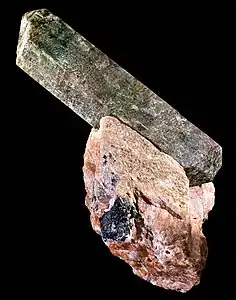
Apatite is a group of phosphate minerals, usually hydroxyapatite, fluorapatite and chlorapatite, with high concentrations of OH−, F− and Cl− ion, respectively, in the crystal. The formula of the admixture of the three most common endmembers is written as Ca10(PO4)6(OH,F,Cl)2, and the crystal unit cell formulae of the individual minerals are written as Ca10(PO4)6(OH)2, Ca10(PO4)6F2 and Ca10(PO4)6Cl2.
The mineral was named apatite by the German geologist Abraham Gottlob Werner in 1786, although the specific mineral he had described was reclassified as fluorapatite in 1860 by the German mineralogist Karl Friedrich August Rammelsberg. Apatite is often mistaken for other minerals. This tendency is reflected in the mineral's name, which is derived from the Greek word ἀπατάω (apatáō), which means to deceive. (Full article...) Image 20
Image 20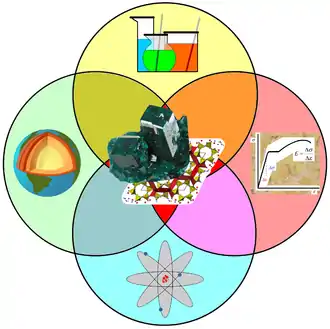 Mineralogy applies principles of chemistry, geology, physics and materials science to the study of minerals
Mineralogy applies principles of chemistry, geology, physics and materials science to the study of minerals
Mineralogy is a subject of geology specializing in the scientific study of the chemistry, crystal structure, and physical (including optical) properties of minerals and mineralized artifacts. Specific studies within mineralogy include the processes of mineral origin and formation, classification of minerals, their geographical distribution, as well as their utilization. (Full article...) Image 21
Image 21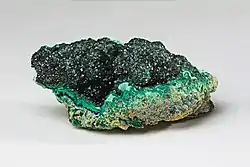 Malachite from the Democratic Republic of the Congo
Malachite from the Democratic Republic of the Congo
Malachite is a copper carbonate hydroxide mineral, with the formula Cu2CO3(OH)2. This opaque, green-banded mineral crystallizes in the monoclinic crystal system, and most often forms botryoidal, fibrous, or stalagmitic masses, in fractures and deep, underground spaces, where the water table and hydrothermal fluids provide the means for chemical precipitation. Individual crystals are rare, but occur as slender to acicular prisms. Pseudomorphs after more tabular or blocky azurite crystals also occur. (Full article...) Image 22
Image 22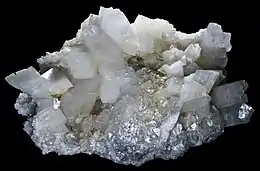 Dolomite (white) on talc
Dolomite (white) on talc
Dolomite (/ˈdɒl.əˌmaɪt, ˈdoʊ.lə-/) is an anhydrous carbonate mineral composed of calcium magnesium carbonate, ideally CaMg(CO3)2. The term is also used for a sedimentary carbonate rock composed mostly of the mineral dolomite (see Dolomite (rock)). An alternative name sometimes used for the dolomitic rock type is dolostone. (Full article...) Image 23
Image 23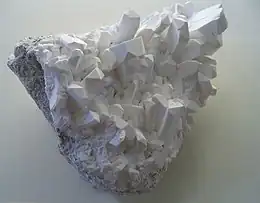
Borax (also referred to as sodium borate, tincal (/ˈtɪŋkəl/) and tincar (/ˈtɪŋkər/)) is a salt (ionic compound), a hydrated or anhydrous borate of sodium, with the chemical formula Na2H20B4O17. It is a colorless crystalline solid that dissolves in water to make a basic solution.
It is commonly available in powder or granular form and has many industrial and household uses, including as a pesticide, as a metal soldering flux, as a component of glass, enamel, and pottery glazes, for tanning of skins and hides, for artificial aging of wood, as a preservative against wood fungus, and as a pharmaceutic alkalizer. In chemical laboratories, it is used as a buffering agent.
The terms tincal and tincar refer to native borax, historically mined from dry lake beds in various parts of Asia. (Full article...) Image 24
Image 24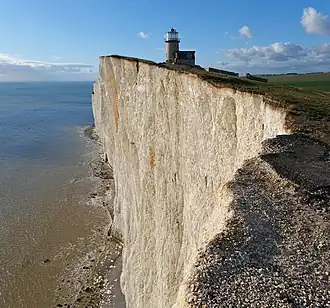 Beachy Head is a part of the extensive Southern England Chalk Formation.
Beachy Head is a part of the extensive Southern England Chalk Formation.
Chalk is a soft, white, porous, sedimentary carbonate rock. It is a form of limestone composed of the mineral calcite and originally formed deep under the sea by the compression of microscopic plankton that had settled to the sea floor. Chalk is common throughout Western Europe, where deposits underlie parts of France, and steep cliffs are often seen where they meet the sea in places such as the Dover cliffs on the Kent coast of the English Channel.
Chalk is mined for use in industry, such as for quicklime, bricks and builder's putty, and in agriculture, for raising pH in soils with high acidity. It is also used for "blackboard chalk" for writing and drawing on various types of surfaces, although these can also be manufactured from other carbonate-based minerals, or gypsum. (Full article...) Image 25
Image 25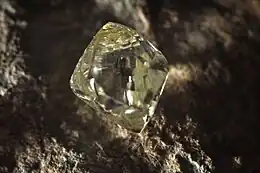 The slightly misshapen octahedral shape of this rough diamond crystal in matrix is typical of the mineral. Its lustrous faces also indicate that this crystal is from a primary deposit.
The slightly misshapen octahedral shape of this rough diamond crystal in matrix is typical of the mineral. Its lustrous faces also indicate that this crystal is from a primary deposit.
Diamond is a solid form of the element carbon with its atoms arranged in a crystal structure called diamond cubic. Another solid form of carbon known as graphite is the chemically stable form of carbon at room temperature and pressure, but diamond is metastable and converts to it at a negligible rate under those conditions. Diamond has the highest hardness and thermal conductivity of any natural material, properties that are used in major industrial applications such as cutting and polishing tools. They are also the reason that diamond anvil cells can subject materials to pressures found deep in the Earth.
Because the arrangement of atoms in diamond is extremely rigid, few types of impurity can contaminate it (two exceptions are boron and nitrogen). Small numbers of defects or impurities (about one per million of lattice atoms) color diamond blue (boron), yellow (nitrogen), brown (defects), green (radiation exposure), purple, pink, orange, or red. Diamond also has a very high refractive index and a relatively high optical dispersion.
Most natural diamonds have ages between 1 billion and 3.5 billion years. Most were formed at depths between 150 and 250 kilometres (93 and 155 mi) in the Earth's mantle, although a few have come from as deep as 800 kilometres (500 mi). Under high pressure and temperature, carbon-containing fluids dissolved various minerals and replaced them with diamonds. Much more recently (hundreds to tens of million years ago), they were carried to the surface in volcanic eruptions and deposited in igneous rocks known as kimberlites and lamproites.
Synthetic diamonds can be grown from high-purity carbon under high pressures and temperatures or from hydrocarbon gases by chemical vapor deposition (CVD). Imitation diamonds can also be made out of materials such as cubic zirconia and silicon carbide. Natural, synthetic, and imitation diamonds are most commonly distinguished using optical techniques or thermal conductivity measurements. (Full article...)
Selected mineralogist
 Image 1
Image 1 Daubenton in 1791
Daubenton in 1791
Louis Jean-Marie Daubenton (29 May 1716 – 1 January 1800) was a French naturalist and contributor to the Encyclopédie ou Dictionnaire raisonné des sciences, des arts et des métiers. (Full article...) Image 2
Image 2
Robert Miller Hazen (born November 1, 1948) is an American mineralogist and astrobiologist. He is a research scientist at the Carnegie Institution of Washington's Geophysical Laboratory and Clarence Robinson Professor of Earth Science at George Mason University, in the United States. Hazen is the Executive Director of the Deep Carbon Observatory. (Full article...) Image 3Ernst Anton Wülfing (27 November 1860, Elberfeld – 17 December 1930, Bad Wörishofen) was a German mineralogist and petrographer, known for his research on the optical properties of minerals and meteorites.
Image 3Ernst Anton Wülfing (27 November 1860, Elberfeld – 17 December 1930, Bad Wörishofen) was a German mineralogist and petrographer, known for his research on the optical properties of minerals and meteorites.
He studied chemistry at Geneva and at Heidelberg as a student of Robert Bunsen, then focused his attention to mineralogy and geology, of which, he studied at Greifswald and Vienna (1887–88). Afterwards he served as an assistant to Harry Rosenbusch at the University of Heidelberg. (Full article...) Image 4Helen Dick Megaw (1 June 1907 – 26 February 2002) was an Irish crystallographer who was a pioneer in X-ray crystallography. She made measurements of the cell dimensions of ice and established the Perovskite crystal structure. (Full article...)
Image 4Helen Dick Megaw (1 June 1907 – 26 February 2002) was an Irish crystallographer who was a pioneer in X-ray crystallography. She made measurements of the cell dimensions of ice and established the Perovskite crystal structure. (Full article...) Image 5Vittorio Simonelli (May 1860, in Arezzo – 9 February 1929, in San Quirico d'Orcia) was an Italian geologist and paleontologist. (Full article...)
Image 5Vittorio Simonelli (May 1860, in Arezzo – 9 February 1929, in San Quirico d'Orcia) was an Italian geologist and paleontologist. (Full article...) Image 6Werner Schreyer (14 November 1930 in Nuremberg; 12 February 2006 in Bochum) was a German mineralogist and experimental metamorphic petrologist. Schreyer completed his undergraduate work in geology and petrology at the University of Erlangen-Nuremberg, obtained his doctorate from the University of Munich in 1957, and in 1966 received his Habilitation from the University of Kiel. He was a professor at Ruhr University Bochum from 1966 to 1996. In 2002 Schreyer became the first German to be awarded the Mineralogical Society of America's highest honor, the Roebling Medal. Schreyer was a leading expert on phase relations in the MgO–Al2O3–SiO2–H2O (MASH) system, specializing in cordierite and minerals with equivalent chemical compositions, and high pressure and ultra high-pressure metamorphic mineral assemblages.
Image 6Werner Schreyer (14 November 1930 in Nuremberg; 12 February 2006 in Bochum) was a German mineralogist and experimental metamorphic petrologist. Schreyer completed his undergraduate work in geology and petrology at the University of Erlangen-Nuremberg, obtained his doctorate from the University of Munich in 1957, and in 1966 received his Habilitation from the University of Kiel. He was a professor at Ruhr University Bochum from 1966 to 1996. In 2002 Schreyer became the first German to be awarded the Mineralogical Society of America's highest honor, the Roebling Medal. Schreyer was a leading expert on phase relations in the MgO–Al2O3–SiO2–H2O (MASH) system, specializing in cordierite and minerals with equivalent chemical compositions, and high pressure and ultra high-pressure metamorphic mineral assemblages.
The mineral Schreyerite (V2Ti3O9) was named after Schreyer. (Full article...) Image 7
Image 7_-_Google_Art_Project_cropped.jpg.webp) James Smithson by Henri-Joseph Johns, 1816
James Smithson by Henri-Joseph Johns, 1816
James Smithson FRS (c. 1765 – 27 June 1829) was a British chemist and mineralogist. He published numerous scientific papers for the Royal Society during the early 1800s as well as defining calamine, which would eventually be renamed after him as "smithsonite". He was the founding donor of the Smithsonian Institution, which also bears his name.
Born in Paris, France, as the illegitimate child of Elizabeth Hungerford Keate Macie and Hugh Percy (born Hugh Smithson), the 1st Duke of Northumberland, he was given the French name Jacques-Louis Macie. His birth date was not recorded and the exact location of his birth is unknown; it is possibly in the Pentemont Abbey. Shortly after his birth he naturalized to Britain where his name was anglicized to James Louis Macie. He adopted his father's original surname of Smithson in 1800, following his mother's death. He attended university at Pembroke College, Oxford in 1782, eventually graduating with a Master of Arts in 1786. As a student he participated in a geological expedition to Scotland and studied chemistry and mineralogy. Highly regarded for his blowpipe analysis and his ability to work in miniature, Smithson spent much of his life traveling extensively throughout Europe; he published some 27 papers in his life. (Full article...) Image 8Dr. E-An Zen (任以安) was born in Peking, China, May 31, 1928, and came to the U.S. in 1946. He became a citizen in 1963. Since 1990 he was adjunct professor at the University of Maryland. He died on March 29, 2014, at the age of 85.
Image 8Dr. E-An Zen (任以安) was born in Peking, China, May 31, 1928, and came to the U.S. in 1946. He became a citizen in 1963. Since 1990 he was adjunct professor at the University of Maryland. He died on March 29, 2014, at the age of 85.
He has contributed articles to professional journals and is a fellow of the Geological Society of America (Councillor, 1985–88, 1990–93; President, 1991–92); the American Association for the Advancement of Science (AAAS), the American Academy of Arts and Sciences, the Mineralogical Society of America (Council, 1974–77;Pres., 1975–76). He is a member of the Geological Society of Washington (Pres. 1973), the National Academy of Sciences, and the Mineralogical Association of Canada. Zen has been active in programs to bring geological knowledge to the general public. (Full article...) Image 9
Image 9 Wolfgang Sartorius von Waltershausen drawn in May 22nd 1843 in Rome by August Kestner
Wolfgang Sartorius von Waltershausen drawn in May 22nd 1843 in Rome by August Kestner
Wolfgang Sartorius Freiherr von Waltershausen (17 December 1809 – 16 March 1876) was a German geologist. (Full article...) Image 10
Image 10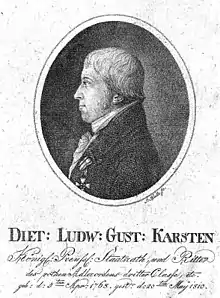
Dietrich Ludwig Gustav Karsten (5 April 1768 – 20 May 1810) was a German mineralogist. Among the most notable of Karsten's writings is a mineralogy book published in 1789 when he was only 21 years old. In later years Karsten held senior government positions in mining and mineralogy in the Kingdom of Prussia at Berlin.
Karsten was born in Bützow, Mecklenburg. His father was a mathematics professor (namely Wenceslaus Johann Gustav Karsten). The son as a teenager studied for four years at the Mining Academy of Freiberg, 1782–1786. A teacher at the Freiberg Mining Academy in those years was Abraham Gottlob Werner, who had recently developed an improved system for classifying minerals and rocks. An earlier student of Werner's, Nathanael Gottfried Leske, had collected a large set of mineral specimens in cooperation with Werner in the 1770s and 1780s. In 1788 Karsten organized and described Leske's collection using Werner's methodology and classification categories. This was published as a 600-page book in German in 1789 entitled "Leske's mineral collection systematically arranged and described". It incorporates information from an unpublished 1780s text of Werner, and it is the first book based on Werner's system. Werner's system was influential in mineralogy throughout Europe in late 18th and early 19th century, and Karsten was one of its leading proponents. (Full article...) Image 11
Image 11.png.webp)
Charles Palache (July 18, 1869 – December 5, 1954) was an American mineralogist and crystallographer. In his time, he was one of the most important mineralogists in the United States. (Full article...) Image 12
Image 12
Peter Woulfe (1727–1803) was an Anglo-Irish chemist and mineralogist. He first had the idea that wolframite might contain a previously undiscovered element (tungsten).
In 1771, Woulfe reported the formation of a yellow dye when indigo was treated with nitric acid. (Full article...) Image 13Friedrich August Frenzel (24 May 1842 – 27 August 1902) was a German mineralogist. He was born in a miner's family in Freiberg, Saxony. In 1861 he was awarded a scholarship which enabled him to study mineralogy at Bergakademie Freiberg. There he attracted the attention of August Breithaupt who asked him to help with organising the mineralogical collections of the academy and with testing mineral samples, and to assist in the professor's mineralogical research. In 1865 Frenzel finished his studies and was awarded the title of a mining inspector. From then on, he worked for 25 years as a chemist in the metallurgical laboratories. He also lectured at the Bergakademie.
Image 13Friedrich August Frenzel (24 May 1842 – 27 August 1902) was a German mineralogist. He was born in a miner's family in Freiberg, Saxony. In 1861 he was awarded a scholarship which enabled him to study mineralogy at Bergakademie Freiberg. There he attracted the attention of August Breithaupt who asked him to help with organising the mineralogical collections of the academy and with testing mineral samples, and to assist in the professor's mineralogical research. In 1865 Frenzel finished his studies and was awarded the title of a mining inspector. From then on, he worked for 25 years as a chemist in the metallurgical laboratories. He also lectured at the Bergakademie.
One of his best known works is the mineralogical encyclopedia for the Kingdom of Saxony (Mineralogisches Lexicon Für Das Königreich Sachsen), which contains descriptions of 723 minerals found in Saxony, information on their physical properties and chemical compositions, and descriptions of the corresponding localities. (Full article...) Image 14
Image 14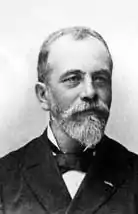 Marcel Alexandre Bertrand
Marcel Alexandre Bertrand
Marcel Alexandre Bertrand (2 July 1847 – 13 February 1907) was a French geologist born in Paris. He was the son of mathematician Joseph Louis François Bertrand (1822–1900), and son-in-law to physicist Éleuthère Mascart (1837-1908).
He studied at the École Polytechnique, and beginning in 1869 he attended the Ecole des Mines de Paris. From 1877 he carried out geological mapping studies of Provence, the Jura Mountains and the Alps. In 1886, he became an instructor at the École Nationale Supérieure des Mines, and in 1896 became a member of the Académie des sciences. (Full article...) Image 15Ernst Friedrich Glocker (1 May 1793 – 18 July 1858) was a German mineralogist, geologist and paleontologist. (Full article...)
Image 15Ernst Friedrich Glocker (1 May 1793 – 18 July 1858) was a German mineralogist, geologist and paleontologist. (Full article...) Image 16W. Gary Ernst (born December 14, 1931) is an American geologist specializing in petrology and geochemistry. He currently is the Benjamin M. Page Professor Emeritus in Stanford University's department of geological sciences.
Image 16W. Gary Ernst (born December 14, 1931) is an American geologist specializing in petrology and geochemistry. He currently is the Benjamin M. Page Professor Emeritus in Stanford University's department of geological sciences.
Ernst was born in St. Louis, Missouri. He received a B.A. degree in geology from Carleton College in 1953, an M.S. in geology from the University of Minnesota of 1955, and a Ph.D. in geochemistry from Johns Hopkins University in 1959. (Full article...) Image 17Warren D. Huff (born April 16, 1937) is Professor of Geology at the University of Cincinnati (UC). He specializes in clay mineralogy, researching the remnants of ancient volcanic eruptions.
Image 17Warren D. Huff (born April 16, 1937) is Professor of Geology at the University of Cincinnati (UC). He specializes in clay mineralogy, researching the remnants of ancient volcanic eruptions.
He received his BA from Harvard College, 1959 and his PhD from University of Cincinnati, 1963. He has served as assistant professor at UC 1963-1969, associate professor 1969-1985, full professor 1985 to date. He teaches introductory geology sequence. (Full article...) Image 18
Image 18 William Phillips
William Phillips
William Phillips FGS FRS (10 May 1775 – 2 April 1828) was an English mineralogist and geologist. (Full article...) Image 19
Image 19 Image 20
Image 20 Rev Dr John Walker, Edinburgh's Professor of Natural History
Rev Dr John Walker, Edinburgh's Professor of Natural History
John Walker FRSE (1731–1803) was a Scottish minister and natural historian. He was Regius Professor of Natural history at the University of Edinburgh from 1779 to 1803. He was joint founder of the Royal Society of Edinburgh in 1783 and Moderator of the General Assembly of the Church of Scotland in 1790. (Full article...) Image 21Peter John Wyllie (born 8 February 1930, in London, England) is a British petrologist and academic.
Image 21Peter John Wyllie (born 8 February 1930, in London, England) is a British petrologist and academic.
He was Professor of Geology at the California Institute of Technology from 1983 until his retirement in 1999. Prior to this, he held positions at the University of St Andrews (1955–56), Pennsylvania State University (1958–59 and 1961–66), the University of Leeds (1959–61), and the University of Chicago (1965–83). He is well known for his many contributions to the understanding of magmatism, particularly through his work on the experimental petrology of magmas and volatiles. In the early 1970s, Wyllie wrote two widely used textbooks; The Dynamic Earth (1971) and The Way the Earth Works (1976) which integrated the new understanding of magmatism and plate tectonics. He is also famous for his contributions to the coverage of earth sciences in the Encyclopædia Britannica, particularly his outline of the field in Part Two of the Propædia. Wyllie was President of the International Union of Geodesy and Geophysics (IUGG) from 1995 to 1999. (Full article...) Image 22Günther Friedrich (15 April 1929 – 24 November 2014) was a German mineralogist and university professor at the RWTH University at Aachen. He was an expert in the field of the creation of marine Manganese nodule concretions. (Full article...)
Image 22Günther Friedrich (15 April 1929 – 24 November 2014) was a German mineralogist and university professor at the RWTH University at Aachen. He was an expert in the field of the creation of marine Manganese nodule concretions. (Full article...) Image 23
Image 23 William Hallowes Miller
William Hallowes Miller
Prof William Hallowes Miller FRS HFRSE LLD DCL (6 April 1801 – 20 May 1880) was a Welsh mineralogist and laid the foundations of modern crystallography.
Miller indices are named after him, the method having been described in his Treatise on Crystallography (1839). The mineral known as millerite is named after him. (Full article...) Image 24Clifford Howard Stockwell (September 26, 1897 – April 26, 1987) was a Canadian geologist, who published many scientific papers, reports and memoirs in the fields of Mineralogy, Structural Geology, Petrology, and Stratigraphy. He earned his PhD in geology at McGill University in Montreal in 1926. (Full article...)
Image 24Clifford Howard Stockwell (September 26, 1897 – April 26, 1987) was a Canadian geologist, who published many scientific papers, reports and memoirs in the fields of Mineralogy, Structural Geology, Petrology, and Stratigraphy. He earned his PhD in geology at McGill University in Montreal in 1926. (Full article...) Image 25
Image 25
Su Song (Chinese: 蘇頌; Pe̍h-ōe-jī: So͘ Siōng, 1020–1101), courtesy name Zirong (Chinese: 子容; Pe̍h-ōe-jī: Chú-iông), was a Chinese polymathic scientist and statesman. Excelling in a variety of fields, he was accomplished in mathematics, astronomy, cartography, geography, horology, pharmacology, mineralogy, metallurgy, zoology, botany, mechanical engineering, hydraulic engineering, civil engineering, invention, art, poetry, philosophy, antiquities, and statesmanship during the Song dynasty (960–1279).
Su Song was the engineer for a hydro-mechanical astronomical clock tower in medieval Kaifeng, which employed an early escapement mechanism. The escapement mechanism of Su's clock tower had been invented by Tang dynasty Buddhist monk Yi Xing and government official Liang Lingzan in 725 AD to operate a water-powered armillary sphere, although Su's armillary sphere was the first to be provided with a mechanical clock drive. Su's clock tower also featured the oldest known endless power-transmitting chain drive, called the tian ti (天梯), or "celestial ladder", as depicted in his horological treatise. The clock tower had 133 different clock jacks to indicate and sound the hours. Su Song's treatise about the clock tower, Xinyi Xiangfayao (新儀象法要), has survived since its written form in 1092 and official printed publication in 1094. The book has been analyzed by many historians, such as the British biochemist, historian, and sinologist Joseph Needham. The clock itself, however, was dismantled by the invading Jurchen army in 1127 AD, and although attempts were made to reassemble it, the tower was never successfully reinstated. (Full article...)
Related portals
Get involved
For editor resources and to collaborate with other editors on improving Wikipedia's Minerals-related articles, see WikiProject Rocks and minerals.
General images
 Image 1Epidote often has a distinctive pistachio-green colour. (from Mineral)
Image 1Epidote often has a distinctive pistachio-green colour. (from Mineral)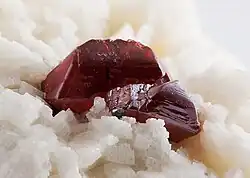 Image 2Red cinnabar (HgS), a mercury ore, on dolomite. (from Mineral)
Image 2Red cinnabar (HgS), a mercury ore, on dolomite. (from Mineral)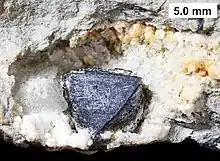 Image 3Sphalerite crystal partially encased in calcite from the Devonian Milwaukee Formation of Wisconsin (from Mineral)
Image 3Sphalerite crystal partially encased in calcite from the Devonian Milwaukee Formation of Wisconsin (from Mineral)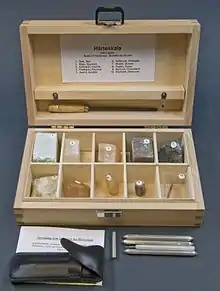 Image 4Mohs hardness kit, containing one specimen of each mineral on the ten-point hardness scale (from Mohs scale)
Image 4Mohs hardness kit, containing one specimen of each mineral on the ten-point hardness scale (from Mohs scale)
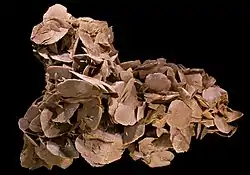 Image 6Gypsum desert rose (from Mineral)
Image 6Gypsum desert rose (from Mineral)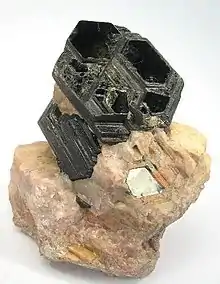 Image 7Perfect basal cleavage as seen in biotite (black), and good cleavage seen in the matrix (pink orthoclase). (from Mineral)
Image 7Perfect basal cleavage as seen in biotite (black), and good cleavage seen in the matrix (pink orthoclase). (from Mineral)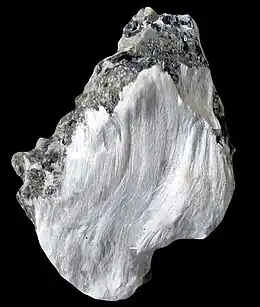 Image 8Asbestiform tremolite, part of the amphibole group in the inosilicate subclass (from Mineral)
Image 8Asbestiform tremolite, part of the amphibole group in the inosilicate subclass (from Mineral)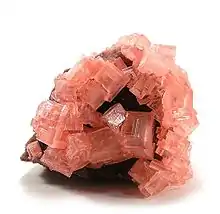 Image 9Pink cubic halite (NaCl; halide class) crystals on a nahcolite matrix (NaHCO3; a carbonate, and mineral form of sodium bicarbonate, used as baking soda). (from Mineral)
Image 9Pink cubic halite (NaCl; halide class) crystals on a nahcolite matrix (NaHCO3; a carbonate, and mineral form of sodium bicarbonate, used as baking soda). (from Mineral)

 Image 12Native gold. Rare specimen of stout crystals growing off of a central stalk, size 3.7 x 1.1 x 0.4 cm, from Venezuela. (from Mineral)
Image 12Native gold. Rare specimen of stout crystals growing off of a central stalk, size 3.7 x 1.1 x 0.4 cm, from Venezuela. (from Mineral)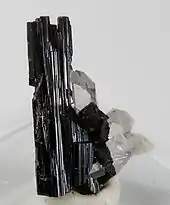 Image 13Hübnerite, the manganese-rich end-member of the wolframite series, with minor quartz in the background (from Mineral)
Image 13Hübnerite, the manganese-rich end-member of the wolframite series, with minor quartz in the background (from Mineral) Image 14Diamond is the hardest natural material, and has a Mohs hardness of 10. (from Mineral)
Image 14Diamond is the hardest natural material, and has a Mohs hardness of 10. (from Mineral)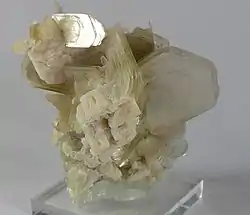 Image 15Muscovite, a mineral species in the mica group, within the phyllosilicate subclass (from Mineral)
Image 15Muscovite, a mineral species in the mica group, within the phyllosilicate subclass (from Mineral)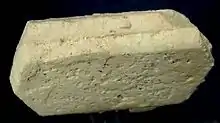 Image 16When minerals react, the products will sometimes assume the shape of the reagent; the product mineral is termed a pseudomorph of (or after) the reagent. Illustrated here is a pseudomorph of kaolinite after orthoclase. Here, the pseudomorph preserved the Carlsbad twinning common in orthoclase. (from Mineral)
Image 16When minerals react, the products will sometimes assume the shape of the reagent; the product mineral is termed a pseudomorph of (or after) the reagent. Illustrated here is a pseudomorph of kaolinite after orthoclase. Here, the pseudomorph preserved the Carlsbad twinning common in orthoclase. (from Mineral)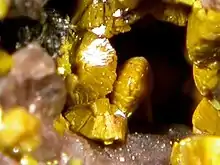


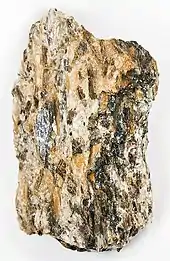 Image 20Schist is a metamorphic rock characterized by an abundance of platy minerals. In this example, the rock has prominent sillimanite porphyroblasts as large as 3 cm (1.2 in). (from Mineral)
Image 20Schist is a metamorphic rock characterized by an abundance of platy minerals. In this example, the rock has prominent sillimanite porphyroblasts as large as 3 cm (1.2 in). (from Mineral)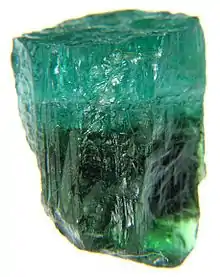 Image 21An example of elbaite, a species of tourmaline, with distinctive colour banding. (from Mineral)
Image 21An example of elbaite, a species of tourmaline, with distinctive colour banding. (from Mineral) Image 22Black andradite, an end-member of the orthosilicate garnet group. (from Mineral)
Image 22Black andradite, an end-member of the orthosilicate garnet group. (from Mineral)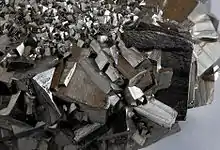
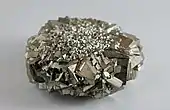
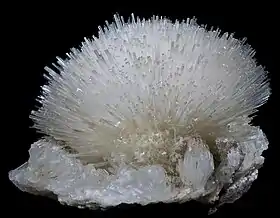
Did you know ...?
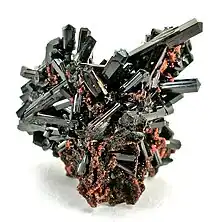
- ... that while manganese-bearing vesuvianite has been studied since 1883, manganvesuvianite (pictured) was not described until 2002?
- ... that the mineral rapidcreekite was discovered in Yukon, Canada, in 1983?
- ... that collinsite was discovered in British Columbia and named for the director of the Geological Survey of Canada?
Subcategories
- Select [►] to view subcategories
Topics
| Overview |  | |
|---|---|---|
| Common minerals | ||
Ore minerals, mineral mixtures and ore deposits | |||||||||
|---|---|---|---|---|---|---|---|---|---|
| Ores |
| ||||||||
| Deposit types | |||||||||
| Borates | |||||
|---|---|---|---|---|---|
| Carbonates | |||||
| Oxides |
| ||||
| Phosphates | |||||
| Silicates | |||||
| Sulfides | |||||
| Other |
| ||||
| Micas |
|
|---|---|
| Talcs |
|
| Pyrophyllite series |
|
| Kaolinites |
|
| Serpentines |
|
| Corrensites | |
| Smectites and vermiculite family |
|
| Chlorites | |
| Allophanes |
|
| Sepiolites |
|
| Pyrosmalites |
|
| Stilpnomelanes |
|
Structural groups mainly; based on rruff.info/ima, modified | |
| Crystalline | |||||||
|---|---|---|---|---|---|---|---|
| Cryptocrystalline | |||||||
| Amorphous | |||||||
| Miscellaneous | |||||||
| Notable varieties |
| ||||||
Titanium minerals | |||||
|---|---|---|---|---|---|
| Oxide minerals |
| ||||
| Silicate minerals | |||||
| Other | |||||
Gemmological classifications by E. Ya. Kievlenko (1980), updated | |||||||||
| Jewelry stones |
| ||||||||
| Jewelry-Industrial stones |
| ||||||||
| Industrial stones |
| ||||||||
Mineral identification | |
|---|---|
| "Special cases" ("native elements and organic minerals") |
|
|---|---|
| "Sulfides and oxides" |
|
| "Evaporites and similars" |
|
| "Mineral structures with tetrahedral units" (sulfate anion, phosphate anion, silicon, etc.) |
|
Associated Wikimedia
The following Wikimedia Foundation sister projects provide more on this subject:
-
 Commons
Commons
Free media repository -
 Wikibooks
Wikibooks
Free textbooks and manuals -
 Wikidata
Wikidata
Free knowledge base -
 Wikinews
Wikinews
Free-content news -
 Wikiquote
Wikiquote
Collection of quotations -
 Wikisource
Wikisource
Free-content library -
 Wikiversity
Wikiversity
Free learning tools -
 Wiktionary
Wiktionary
Dictionary and thesaurus
References
-
 List of all portalsList of all portals
List of all portalsList of all portals -
 The arts portal
The arts portal -
 Biography portal
Biography portal -
 Current events portal
Current events portal -
 Geography portal
Geography portal -
 History portal
History portal -
 Mathematics portal
Mathematics portal -
 Science portal
Science portal -
 Society portal
Society portal -
 Technology portal
Technology portal -
 Random portalRandom portal
Random portalRandom portal -
 WikiProject PortalsWikiProject Portals
WikiProject PortalsWikiProject Portals
